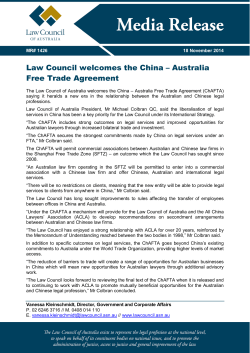
FACT SHEET - Australian Maritime Safety Authority
FACT SHEET Australia’s National Plan for Maritime Environmental Emergencies Australia’s National Plan for Maritime Environmental Emergencies (the National Plan) describes how governments and industry will co-operate to respond to shipping casualties and maritime spills. The Australian Maritime Safety Authority (AMSA) manages the National Plan – working with Commonwealth and State/ Northern Territory (NT) government agencies, and the shipping, ports, offshore petroleum production and exploration, oil, salvage and chemical industries. The National Plan provides a national framework for responding promptly and efficiently to marine pollution incidents and maritime casualties through: • Governance and policy to ensure accountability, risk assessment and stakeholder engagement; • Preventing shipping casualties through a system of emergency towage capability around the Australian coastline; • A Maritime Emergency Response Commander (MERCOM) to coordinate the national response to serious maritime casualties; • Responding to maritime spills using appropriate levels of contingency plans, equipment stockpiles, training and exercises. Governance structure The National Plan Strategic Coordination Committee (NPSCC) has representatives of all the Commonwealth and State/NT government agency heads and the Chair of the industry committee. This committee sets the broad policy direction of the National Plan, oversees its implementation and reviews its effectiveness. The committee is supported by technical groups that provide advice on casualty response, and pollution prevention and response. The industry sectors (shipping, offshore production, oil, chemicals, ports, salvage and fire authorities) have their own independent advisory committee known as the National Plan Strategic Industry Advisory Forum (NSIAF) that also provides advice to the NPSCC. Each State and the Northern Territory has its own committee to coordinate activities within their jurisdiction. The Australian Government National Plan Committee (AGNPC) is responsible for coordinating the activities of Commonwealth agencies under the National Plan. Divisions of Responsibility The roles and responsibilities of National Plan participants are clearly defined in the National Plan. The National Plan framework is underpinned by a range of policies, guidelines and technical and operational documents. They are generally developed and reviewed by the Technical Groups and the NPSIAF before adoption by the NPSCC. They describe arrangements for equipment access, maintenance and storage, training and exercising of response personnel, joint use of national resources, and funding. Australian Maritime Safety Authority, Canberra ACT Australia – December 2014 AMSA237 (12/14) Page 1 of 2 Fact Sheet - Australia’s National Plan for Maritime Environmental Emergencies Maritime Casualty Management and Emergency Towage Capability A maritime casualty management system has been incorporated into the National Plan, to assist ships that are incapacitated and in danger of grounding, sinking or otherwise causing pollution. Emergency Towage Vessels (ETV’s) are strategically located along the Australian coast to deal with significant, or potentially significant, threats to Australia’s marine environment. AMSA provides the Coral Knight, based in Cairns and available for emergency tasking by AMSA in the event of a maritime casualty. Other ETV’s are either vessels contracted by AMSA to be available in the event of an incident or suitable vessels that are in the relevant area at the time of the incident that are used as “vessels of opportunity”. A Maritime Emergency Response Commander (MERCOM) is appointed by AMSA to act on behalf of the Authority during a shipping casualty. The MERCOM is responsible for the management of responses to shipping incidents, with statutory intervention powers to take measures to prevent, mitigate or eliminate a risk of significant pollution, including the power to direct a port to release a tug to provide emergency assistance or designate a place of refuge for a ship in emergency situations that present a risk of significant pollution. Funding Funding of Commonwealth responsibilities under the National Plan is based on the potential-polluterpays principle. To achieve this, a levy is imposed on commercial shipping using Australian ports. This levy provides funds for ongoing development, maintenance and administration of the National Plan, including the acquisition, storage and maintenance of the equipment and training programs. Training National Plan training conducted by AMSA focuses on incident management team training. This course is designed to provide all personnel likely to be involved in a response to a marine pollution incident with the information and skills they will need to be effective. Additionally, specialised courses are available to provide further skills in the roles of: • Incident Controller • Planning • Operations • Logistics. AMSA also offers courses in shoreline clean-up and equipment operation. All courses are delivered under the AMS Registered Training Organisation in line with the requirements of the Australian Qualifications Framework. This training is supported by exercises and various workshops delivered by AMSA, the States and the Northern Territory. Further details of National Plan response, planning, casualty management and training can be found on the AMSA website. For more information on how Australian authorities respond to oil and chemical spills in the marine environment under National Plan arrangements, see the ‘How Australia responds to oil and chemical spills in the marine environment’ factsheet. For more information on response and intervention for maritime casualties see the ‘Maritime Casualty Management and Emergency Towage Capability’ factsheet. The levy also covers any costs incurred when a spill occurs and no polluting vessel is identified and so costs cannot be recovered from the actual polluter. States and the Northern Territory, and industry also fund National Plan functions, such as providing equipment and local training. Australian Maritime Safety Authority, Canberra ACT Australia – December 2014 AMSA237 (12/14) Page 2 of 2
© Copyright 2025





















